THE THREE BATTLES OF LOUDOUN HILL |
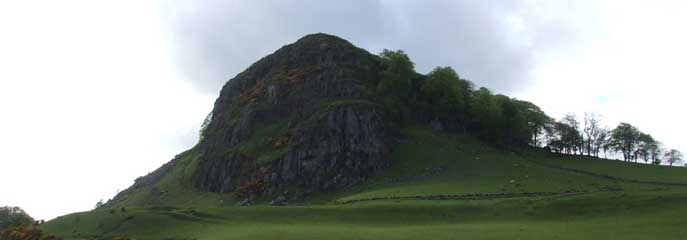 |
Loudoun Hill marks the eastern end of the Irvine Valley. From its summit there is an extensive view over Ayrshire to the Firth of Clyde and Arran. The hill has witnessed the passage of history from the earliest times. An iron-age homestead is located at the foot of the south-east slope. Nearby at Allanton Beg a Roman fort was built. The current A71 is probably the line of the Roman road as it left the fort. Sir William Wallace defeated an English force at Loudoun Hill in 1296 and King Robert the Bruce inflicted greater punishment on the English in 1307. A large Conventicle (outdoor religious service) held in the vicinity in 1679 led on to the humiliation of Claverhouse by the covenanters at the battle of Drumclog. |
Wallace & the First Battle |
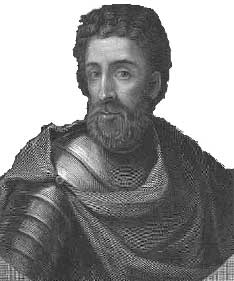 |
A number of places in Loudoun and Galston parishes are associated with William Wallace, but Blind Harry in his epic poem “The Wallace” tells the story of Wallace’s ambush of the English at Loudoun Hill. The poem also tells how somewhere within the parish a hospitable innkeeper supplied the party of Scots as they prepared to intercept a convoy on route westward to Ayr. The actual battlesite was probably at the eastern entrance to the narrow pass known as the Winny Wizzen, it's strategic position at the head of the valley meant it was often passed by armies making their way inland or out to the coast. Wallace concealed his men behind the banks and ditches of the long abandoned Roman fort. The poem tells how the Scots made the way even narrower with the construction of stone dykes, making more effective the attack on the tightly packed riders. Wallace had only 50 men against 200 enemy soldiers but still managed to win the day, killing over 100 English troops including Fenwick (the English general who had killed Wallace’s father), the rest scattered and the baggage train, with all the supplies including a large amount of useful armour, weapons and horses |
intended to relieve the garrison at Ayr, now fell into Scottish hands. A point marked on maps as Wallace’s Grave is traditionally believed to be the place where the English dead were buried. Wallace was declared an outlaw after the Battle of Loudoun Hill but pressed on to his great victory at Stirling Bridge the following year. September 2004 saw the unveiling of the "Spirit of Scotland" statute - to recognise the historical significance of the area during the Scottish Wars of Independence. |
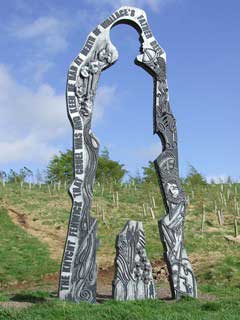 |
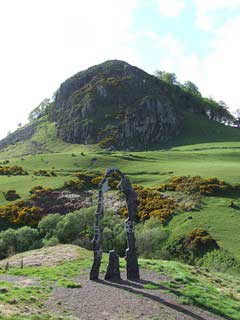 |
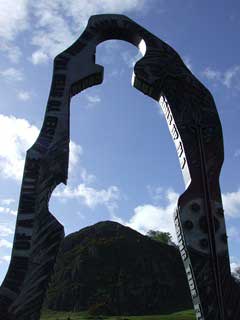 |
Bruce & the Second Battle |
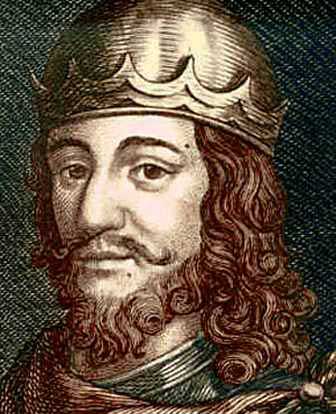 |
In 1307 on 10th May, eleven years after the first battle of Loudoun Hill, King Robert the Bruce adopted, almost exactly, the same site and tactics for another encounter with the English. Modern interpretation places the battlefield further east on the farm of Allanton plains, between the bog land on the north and Loch Gait, now drained, beside the Avon Water. By digging a series of trenches on either side he succeeded in narrowing the passage, forcing the English onto the difficult terrain between the bog and the loch. The commander of the English was an old foe, namely one Aymer de Valence, who Bruce was more than familiar with. |
John Barbour describes his actions in his rhyming chronicle; |
The king upon the other side, Whose prudence was his valour's guide, Rode out to see and chose his ground. The highway took its course, he found, Upon a medow, smooth and dry. But close on either side therby A bog extended, deep and broad, That from the highway, where men rode, Was full a bowshot either side. |
Valence's only approach was over the highway through the bog, where the parallel ditches Bruce's men dug outwards from the marsh restricted his room for deployment still further, effectively neutralising his advantage in numbers. He was forced at attack along a narrowly constricted front upwards towards the waiting enemy spears. It was a battle reminiscent in some ways of Stirling Bridge, with the same 'filtering' effect at work. |
The king's men met them at the dyke |
As Bruce's spearmen pressed downhill on the disorganised English knights they fought with such vigour that the rear ranks began to flee in panic. A hundred or more were killed in the battle. Amyer de Valence managed to escape the carnage and fled to the safety of Bothwell Castle. |
The Covenanters & the Third Battle |
 |
The Covenanters were a group of people who had signed The National Covenant (1638) in protest when King James I attempted to bring the Kirk into line with the Anglican Church, complete with its hierarchy of Bishops and the English prayer book. |
John Graham of Claverhouse, commander of government troops in south-west Scotland, received information that a large conventicle (outlawed outdoor religious service) had congregated near Loudoun Hill. Numbering well over 1000 people the conventicle demonstrated the strength of the covenanting support in Ayrshire, the Irvine Valley and Avondale. The minister, the Rev. Thomas Douglas broke off his sermon with the words “Ye have got the theory, now for the practice” and the small army moved off to meet Claverhouse who was approaching from Strathaven. When Claverhouse and his men approached they were surprised to find that the covenanters were not actually engaged in prayer or worship – but instead were lined up ready for battle. Claverhouse’s soldiers numbered around 150 – the covenanting army about 300 of which only 50 were mounted. The weaponry of some of the covenanters was basic and included pikes and pitchforks. The covenanters won the day however – with only a few of their number falling in battle. One man who fell defending his faith was Thomas Fleming. He was buried at Loudoun Kirk. Sadly the stone was later vandalised but the Scottish Covenanting Memorials Association repaired it. The stone has now been re-positioned against a wall to hopefully prevent any further damage intentional or otherwise. |
We'd Like To Thank EAST AYRSHIRE COUNCIL for their help with this history lesson |
 |
© Paisley Tartan Army 2008-09
